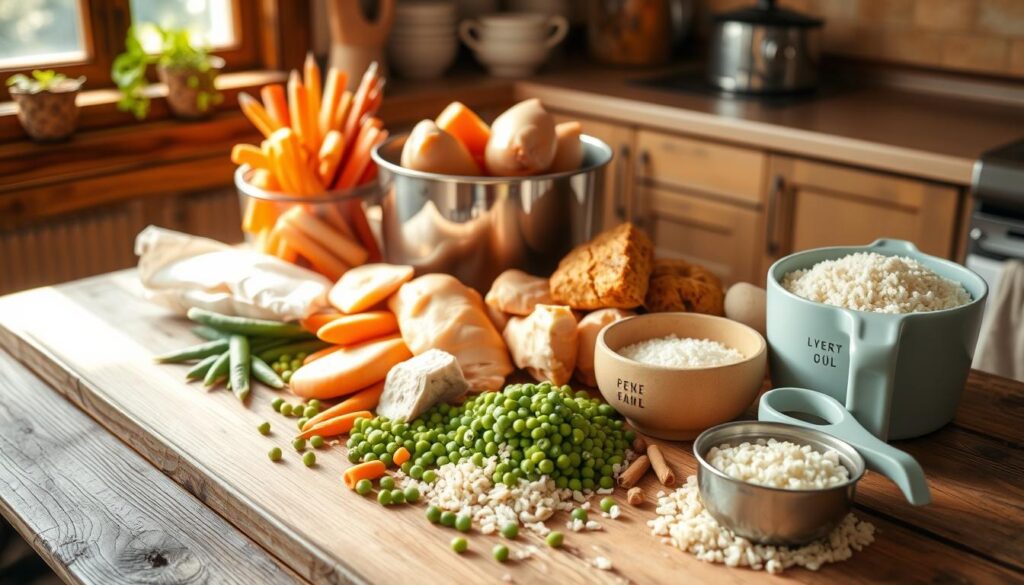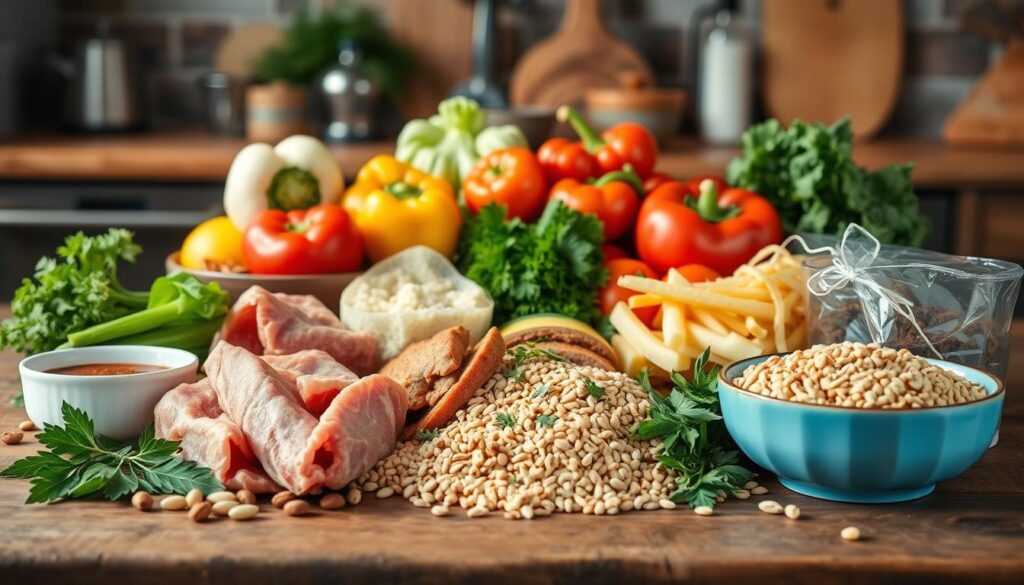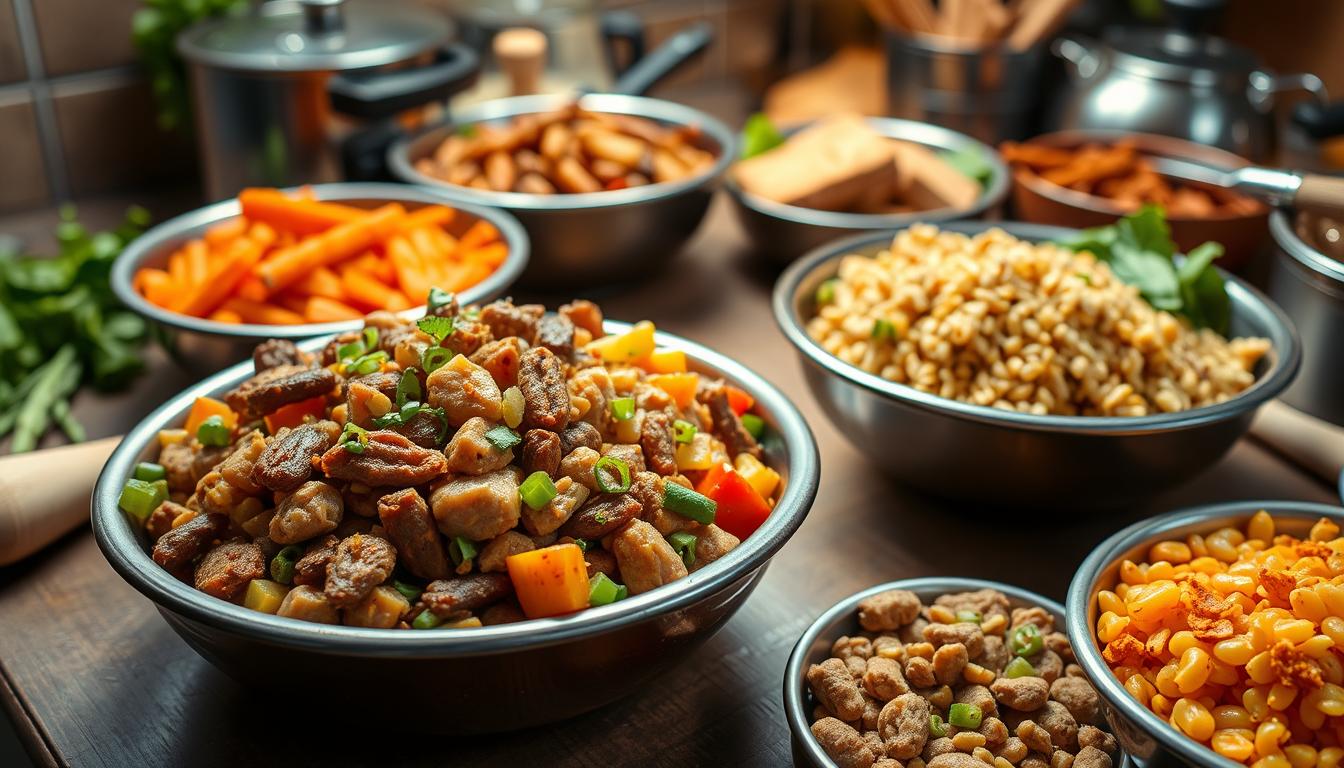Key Takeaways
- Vet-approved homemade dog food recipes offer a customizable and healthier alternative to commercial kibble.
- Understanding your dog’s unique nutritional needs is essential for creating a balanced and complete homemade diet.
- Incorporating the right combination of high-quality proteins, carbohydrates, and essential vitamins and minerals is crucial for a well-rounded homemade dog food.
- Certain human foods can be unsafe for dogs, and it’s important to avoid them when preparing homemade meals.
- Proper meal prep and storage techniques are necessary to ensure the safety and longevity of your homemade dog food.
Understanding the Importance of Veterinary-Guided Dog Nutrition
Getting professional advice for your dog’s diet is key. Dogs need different foods based on their age, how active they are, and any health issues. Following recipes without a vet’s help can be dangerous.
Key Nutritional Requirements for Dogs
Dogs need a mix of proteins, fats, carbs, vitamins, and minerals. The right mix keeps them healthy. Vets can figure out the best mix for your dog.
Why Professional Guidance Matters
Vets know what your dog needs and can give you the right advice. They help avoid diet mistakes that can harm your dog. Their advice ensures your dog stays healthy for a long time.
Common Nutritional Deficiencies to Avoid
- Protein deficiency: Can lead to muscle wasting and weakened immune system.
- Calcium and phosphorus imbalance: Can result in skeletal problems and other health issues.
- Vitamin and mineral deficiencies: May contribute to vision problems, poor coat condition, and reduced energy levels.
Working with your vet helps make a safe homemade dog food plan. This plan meets your pet’s dog nutritional needs. It also avoids the dangers of veterinary nutrition advice and canine dietary requirements.
Essential Ingredients for Balanced Homemade Dog Food
Making homemade dog food needs a mix of key ingredients. Knowing what’s good for your dog’s diet is key. We’ll look at the main parts of balanced dog food ingredients, homemade dog food nutrition, and healthy dog food components.
Protein Sources
Protein is vital for dogs, helping with muscle growth and health. Choose lean meats like chicken, turkey, or fish. Mixing different proteins ensures your dog gets all the amino acids they need.
Carbohydrates and Fiber
Carbs give energy, and fiber helps digestion. Use whole grains like brown rice or oats. Add veggies like sweet potatoes or carrots for fiber. These healthy dog food components keep your dog’s energy up and support their gut.
Healthy Fats
Fats are key for energy and skin health. Add healthy fats like salmon oil or coconut oil. They give your dog omega-3 and omega-6 fatty acids.
Vitamins and Minerals
Add vitamins and minerals like calcium and iron to your dog’s food. These balanced dog food ingredients boost their health and immune system.
By using these key ingredients, your homemade dog food will be nutritious. Always check with your vet to make sure your dog’s diet is right for them.
Safe and Unsafe Food Ingredients for Dogs
As a responsible pet owner, knowing which foods are safe for your dog is key. Some human foods are okay in small amounts, but others can be very harmful. Let’s look at what foods are safe and what to avoid.
Toxic Foods to Avoid
Some common foods can be very dangerous for dogs. Chocolate, onions, garlic, grapes, raisins, and xylitol (a sugar substitute) are toxic and should be kept away. These foods can cause serious health problems, including stomach issues and organ failure.
Beneficial Superfoods for Dogs
- Lean meats: Chicken, turkey, and lean beef are great dog-safe foods full of protein.
- Fish: Salmon, tuna, and sardines are packed with omega-3 fatty acids, good for canine superfoods and healthy skin and coat.
- Vegetables: Carrots, sweet potatoes, green beans, and spinach are dog-safe foods rich in nutrients for homemade meals.
- Fruits: Blueberries, apples, and pumpkin are canine superfoods that offer antioxidants and fiber.
Portion Control Guidelines
It’s important to control the amount of food your dog eats to keep them healthy. Dogs should eat two to three meals a day, with the right amount based on their age, size, and activity level. Talk to your vet to find out the best dog food portioning for your dog.
“Proper nutrition is the foundation of your dog’s health and well-being. By understanding which foods are safe and which are harmful, you can create delicious and balanced homemade meals that will keep your furry companion thriving.”
Vet Approved Homemade Dog Food Recipes
It’s crucial to give your dog a balanced diet for their health. Luckily, there are many vet-approved homemade dog food recipes. These recipes make tasty, healthy meals for your furry friend.
These veterinarian-approved dog recipes have the right mix of protein, carbs, vitamins, and minerals. They ensure your dog gets all the nutrients they need. If you want to switch to homemade food or add more homemade meals, these homemade dog food formulas are a good choice.
Baked Chicken and Sweet Potato Dog Dish
This recipe mixes lean chicken, sweet potatoes, and veggies for a balanced canine meal. Bake the ingredients together and serve in controlled portions. It’s a tasty, healthy meal for your dog.
- 2 boneless, skinless chicken breasts, cubed
- 2 cups diced sweet potatoes
- 1 cup chopped green beans
- 1/2 cup diced carrots
- 1/4 cup rolled oats
- 2 tablespoons olive oil
- 1 teaspoon dried parsley
| Nutrient | Amount per Serving |
|---|---|
| Protein | 25g |
| Carbohydrates | 35g |
| Fat | 12g |
| Fiber | 5g |
This recipe is a top choice for veterinarian-approved dog recipes. It offers a balanced canine meal with lean protein, complex carbs, and essential vitamins and minerals. It’s a nutritious, tasty option for your dog’s homemade diet.

“Homemade dog food can be a great way to ensure your pet is getting the proper nutrition they need, and these vet-approved recipes are a wonderful starting point.”
– Dr. Jane Smith, Veterinarian
Protein-Rich Recipe Options for Active Dogs
Active dogs need more protein to keep their energy up. We offer recipes packed with protein to meet their needs. Our vet-approved meals come in lean meats, fish, and plant-based options. They suit all kinds of dogs, no matter their diet or activity level.
Lean Meat Combinations
Lean meats like beef, chicken, or turkey are great for protein. They’re also low in fat, perfect for active dogs. Mix these with veggies and whole grains for a balanced, vet-approved meal.
Fish-Based Alternatives
Fish like salmon or sardines are full of protein and omega-3s. They’re good for active dogs, supporting healthy skin and coat. Serve fish with brown rice and veggies for a tasty, nutritious meal.
Plant-Based Protein Sources
- Lentils
- Chickpeas
- Quinoa
- Peanut butter
Plant-based proteins are great for eco-friendly or vegetarian dog owners. They can be mixed with lean meats or used alone. This ensures your dog gets the nutrients they need.
“By focusing on high-protein, nutrient-dense ingredients, you can craft homemade meals that provide the energy and nourishment your active dog needs to live their best life.”
Always talk to your vet before changing your dog’s diet, especially to homemade meals. They can help make sure your dog gets the right nutrients.
Special Diet Recipes for Dogs with Health Conditions
Our dogs have different nutritional needs based on their health. Giving them therapeutic dog diets and health condition-specific dog food is key for their health. These specialized canine nutrition recipes meet the dietary needs of dogs with health issues like obesity, diabetes, and kidney problems.
If your dog has a health issue, these vet-approved recipes can help. They can bring balance and improve your dog’s health. Here are some tasty and healthy options for our furry friends with special needs.
Recipes for Canine Obesity
- Lean Turkey and Sweet Potato Stew
- Broccoli and Quinoa Dog Bites
- Pumpkin and Carrot Meatballs
Diabetes-Friendly Recipes
- Grilled Salmon and Asparagus
- Brown Rice and Chicken Casserole
- Blueberry and Oat Dog Treats
Kidney-Supportive Recipes
| Recipe | Key Ingredients | Benefits |
|---|---|---|
| Baked Tilapia and Spinach | Tilapia, spinach, brown rice | Low-protein, high-quality protein and nutrient-dense |
| Roasted Chicken and Cauliflower | Chicken, cauliflower, sweet potato | Moderate protein, high in fiber and antioxidants |
| Homemade Peanut Butter Bites | Peanut butter, oats, banana | Protein-rich, low in phosphorus, and easy to digest |
Always talk to your vet before changing your dog’s diet, especially if they have a health issue. With their help and these therapeutic dog diets, your dog will get the specialized canine nutrition they need to stay healthy.

“Providing the right health condition-specific dog food can make all the difference in the world for a dog’s overall health and well-being.”
Meal Prep and Storage Guidelines
It’s key to prepare and store your homemade dog food right. This keeps it safe and fresh for longer. Knowing the best ways to store and freeze your dog’s food can simplify your life. Let’s look at the main tips for meal prepping for your dog.
Proper Storage Techniques
Storing your homemade dog food correctly is vital. Here are some tips to remember:
- Refrigerate meals right after making and use them in 3-5 days.
- Put portions in airtight containers or bags to stop air and germs.
- Mark each container with the date and what’s inside to track freshness.
- Don’t leave food at room temperature, as it can grow bacteria.
Freezing and Thawing Tips
Freezing is a great way to keep your dog food fresh longer. Here’s how to freeze and thaw it right:
- Split food into portions before freezing for easy thawing and serving.
- Use containers or bags safe for the freezer, leaving space for expansion.
- Label containers with what’s inside and the date for tracking.
- Thaw in the fridge, not at room temperature, for safety and quality.
Food Safety Practices
When making homemade dog food, follow food safety rules to avoid illness. Always:
- Wash hands before and after touching food or ingredients.
- Clean and sanitize all tools, surfaces, and containers used.
- Cook meats and ingredients to safe internal temperatures.
- Throw away any leftover food that’s been out for over 2 hours.
By sticking to these guidelines, your homemade dog food stays fresh, healthy, and safe for your dog.
Transitioning Your Dog to Homemade Food
Switching your dog’s food from commercial to homemade needs a careful plan. This step is key to help your dog’s stomach adjust without upset. Start by adding a little of the new food to their old diet. Gradually increase the new food over 7-10 days.
Watch how your dog reacts to the new food closely. Look for better energy, a shinier coat, and overall health. If your dog has stomach problems, like vomiting or diarrhea, slow down the change. Or talk to your vet for advice on a slower introduction.
Be ready to tweak the recipes as you go. Some dogs need more protein, while others do well on plants. Stay open to changes and work with your vet to keep your dog’s diet balanced.

